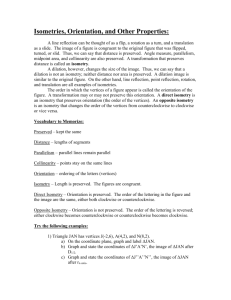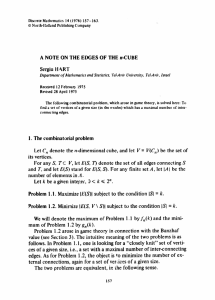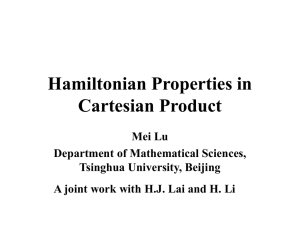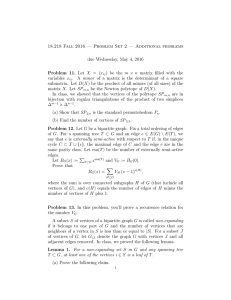Beitr¨ age zur Algebra und Geometrie Contributions to Algebra and Geometry
advertisement
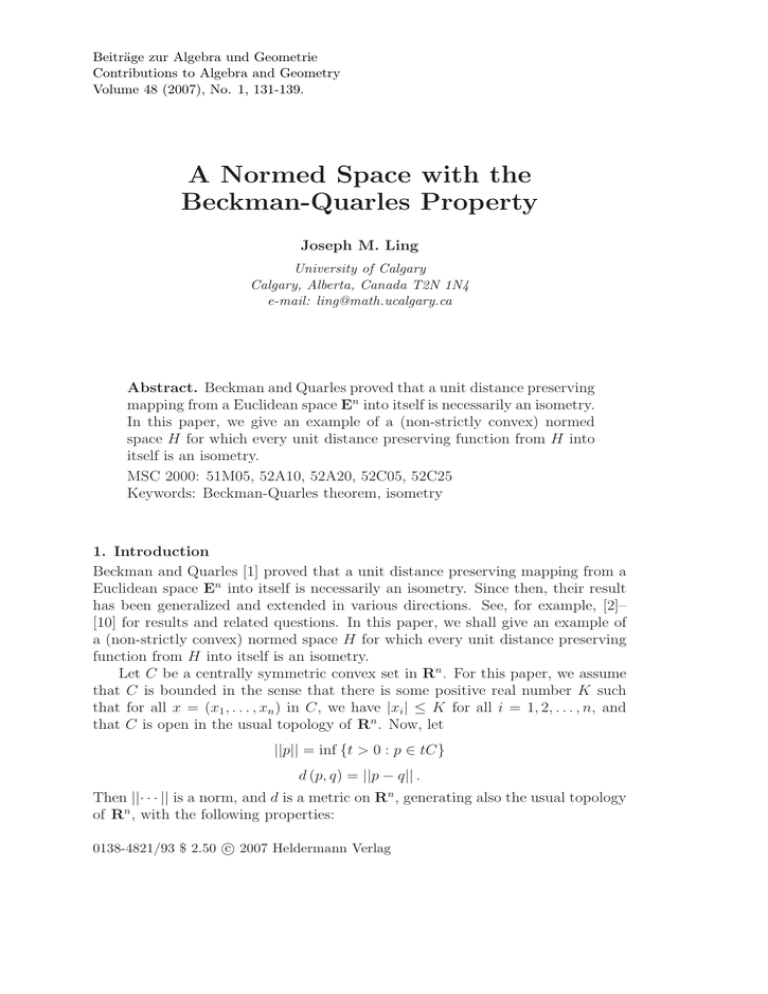
Beiträge zur Algebra und Geometrie
Contributions to Algebra and Geometry
Volume 48 (2007), No. 1, 131-139.
A Normed Space with the
Beckman-Quarles Property
Joseph M. Ling
University of Calgary
Calgary, Alberta, Canada T2N 1N4
e-mail: ling@math.ucalgary.ca
Abstract. Beckman and Quarles proved that a unit distance preserving
mapping from a Euclidean space En into itself is necessarily an isometry.
In this paper, we give an example of a (non-strictly convex) normed
space H for which every unit distance preserving function from H into
itself is an isometry.
MSC 2000: 51M05, 52A10, 52A20, 52C05, 52C25
Keywords: Beckman-Quarles theorem, isometry
1. Introduction
Beckman and Quarles [1] proved that a unit distance preserving mapping from a
Euclidean space En into itself is necessarily an isometry. Since then, their result
has been generalized and extended in various directions. See, for example, [2]–
[10] for results and related questions. In this paper, we shall give an example of
a (non-strictly convex) normed space H for which every unit distance preserving
function from H into itself is an isometry.
Let C be a centrally symmetric convex set in Rn . For this paper, we assume
that C is bounded in the sense that there is some positive real number K such
that for all x = (x1 , . . . , xn ) in C, we have |xi | ≤ K for all i = 1, 2, . . . , n, and
that C is open in the usual topology of Rn . Now, let
||p|| = inf {t > 0 : p ∈ tC}
d (p, q) = ||p − q|| .
Then ||· · · || is a norm, and d is a metric on Rn , generating also the usual topology
of Rn , with the following properties:
c 2007 Heldermann Verlag
0138-4821/93 $ 2.50 132
J. M. Ling: A Normed Space with the Beckman-Quarles Property
(1) d is translation invariant:
d (ta (p) , ta (q)) = d (p, q)
for all a ∈ Rn , where ta (z) = a + z. In other words, if we use Md to denote
the metric space (Rn , d), then translations are isometries on Md .
(2) The reflection σ about the origin is an isometry:
d (σ (p) , σ (q)) = d (p, q)
for all p, q in Md .
Examples of Md include the Euclidean space En (C being the usual open unit
ball defined by the inequality x21 + x22 + · · · + x2n < 1), and more generally, the lp
spaces (C being defined by |x1 |p + |x2 |p + · · · + |xn |p < 1) for 1 ≤ p. We may also
look at l∞ , where C is defined by max {|x1 | , |x2 | , . . . , |xn |} < 1. For l∞ , there is
a tiling of all of Rn by lattice translates of (the closure of) C. For R2 , l1 also
has this property. Another d that has this property for R2 comes from taking
C = Q + (−Q), where Q is {(x, y) : x > 0, y > 0, x + y < 1}, the interior of the
convex hull of {0, e1 , e2 }, where as usual, e1 = (1, 0) and e2 = (0, 1). Here C is
the (interior of the) hexagon with vertices ±e1 , ±e2 , and ± (e1 − e2 ). This space
will become our main object of study below, and we shall just refer it as H.
Now, according to the Beckman-Quarles theorem for the Euclidean plane En ,
if ϕ : En → En is unit distance preserving, then ϕ is an isometry on E2 . That is,
condition
(1) for all p, q ∈ En , d (p, q) = 1 ⇒ d (ϕ (p) , ϕ (q)) = 1
implies condition
(2) for all p, q ∈ En , d (ϕ (p) , ϕ (q)) = d (p, q).
We propose to say that Md has the Beckman-Quarles property if every unit distance preserving map ϕ : Md → Md is an isometry on Md .
It is immediate that not all Md have the Beckman-Quarles property. The
simplist example is l∞ on Rn . Indeed, the map ϕ : l∞ → l∞ defined by
ϕ (x1 , x2 , . . . , xn ) = (bx1 c , bx2 c , . . . , bxn c) ,
is unit distance preserving, but is not an isometry. (Here, bxc is the floor of x,
i.e., the largest integer not larger than x.) The situation for l1 on R2 is clear, too.
These examples make one wonder if the existence or non-existence of tiling of
n
R by translates of C plays a determining factor. In this regard, we note that H
has the Beckman-Quarles property, and it is the purpose of this article to supply
a prove for this fact.
2. Main result
H has the Beckman-Quarles property.
In this section, we let ϕ : H → H be a unit distance preserving mapping, and fix
it for our discussion. That is, for p, q ∈ H,
d (p, q) = 1 ⇒ d (ϕ (p) , ϕ (q)) = 1.
J. M. Ling: A Normed Space with the Beckman-Quarles Property
133
The following claims follow immediately. We omit their proofs.
Lemma 1. For p ∈ H, let Sp = {q ∈ H : d (p, q) = 1} denote the unit circle
centered at p. The following hold.
(1) ϕ (Sp ) ⊆ Sϕ(p) for all p ∈ H.
(2) If p, q, r are vertices of a unit equilateral triangle, i.e., d (p, q) = d (q, r) =
d (r, p) = 1, then so are ϕ (p) , ϕ (q) , ϕ (r).
(3) For all p ∈ H, Sp does not contain all three vertices of any unit equilateral
triangle.
For any p ∈ H, we consider the six “vertices” of Sp as follows:
p1 = p + e1 , p2 = p + e2 , p3 = p − e1 + e2 ,
p4 = p − e1 , p5 = p − e2 , p6 = p + e1 − e2 .
We call pi and pi+1 adjacent vertices of Sp , where we also take p7 to mean p1 . (In
the following discussion, we shall assume that indices are treated with modulo 6,
unless otherwise stated.) In terms of this notation, we note the following facts.
Again, we omit the proofs.
Lemma 2. Let p ∈ H, and let i ∈ {1, 2, . . . , 6}. Then
(1) p = (pi )i+3 = (pi )i−3 .
(2) pi = (pi−1 )i+1 = (pi+1 )i−1 .
(3) Let mi+j ∈ [p, pi+j ] for j ∈ J, where J = {1, 3, 5} or {2, 4, 6}. Then
{mi+j : j ∈ J} is the set of vertices of a unit equilateral triangle if and only if
mi+j = (p + pi+j ) /2 for all j ∈ J. (Here, [p, q] = {λp+(1−λ) q : 0 ≤ λ ≤ 1}.)
(4) Sp is the union of six line segments: Sp = ∪6i=1 [pi , pi+1 ].
Now, we can start to investigate the properties of unit distance preserving maps
ϕ : H → H.
Lemma 3. Let ϕ (p) = q. The following hold.
(1) For each i = 1, 2, . . . , 6, ϕ (pi ) is a vertex of Sq , i.e., there is some j ∈
{1, 2, . . . , 6} such that ϕ (pi ) = qj .
(2) Adjacent vertices of Sp are mapped onto adjacent vertices of Sq . That is, if
ϕ (pi ) = qj , then {ϕ (pi−1 ) , ϕ (pi+1 )} ⊆ {qj−1 , qj+1 }.
(3) There is a j ∈ {1, 2, . . . , 6} such that either ϕ (pi ) = qj+i for all i, or ϕ (pi ) =
qj−i for all i.
Proof. (1) Suppose that ri = ϕ (pi ) is not a vertex of Sq . Since ri ∈ Sq , there
must be some j such that ri belongs to the relative interior of the line segment
[qj , qj+1 ]. Thus, there is some λ ∈ (0, 1) such that
ri = λqj + (1 − λ) qj+1 .
134
J. M. Ling: A Normed Space with the Beckman-Quarles Property
To facilitate our later discussion, we write
ri+k = λqj+k + (1 − λ) qj+k+1 ,
for all k. Also, for the same reason, we let
mk =
p + pk
2
for all k. Now, as
{pi−1 , pi+1 } = S (p) ∩ S (pi ) ,
we have
{ϕ (pi−1 ) , ϕ (pi+1 )} ⊆ S (q) ∩ S ri = ri−1 , ri+1 .
Suppose now that ϕ (pi−1 ) 6= ϕ (pi+1 ). Then {ϕ (pi−1 ) , ϕ (pi+1 )} = {ri−1 , ri+1 }.
As
[p, pi ] = S (pi−1 ) ∩ S (pi+1 ) ,
we have
ϕ ([p, pi ]) ⊆ S (ϕ (pi−1 )) ∩ S (ϕ (pi+1 )) = S ri−1 ∩ S ri+1 = q, ri .
In particular, ϕ (mi ) = q or ri .
If ϕ (mi ) = q, then as
mi+2 ∈ S (pi+1 ) ∩ S mi , and mi−2 ∈ S (pi−1 ) ∩ S mi ,
we have
ϕ mi+2 ∈ S (ϕ (pi+1 )) ∩ S (q) , and ϕ mi−2 ∈ S (ϕ (pi−1 )) ∩ S (q) .
In particular,
ϕ mi+2 , ϕ mi−2
⊆ (S (ϕ (pi+1 )) ∪ S (ϕ (pi−1 ))) ∩ S (q)
= S ri−1 ∪ S ri+1 ∩ S (q)
= ri , ri−2 , ri+2 .
But this is impossible, as d (mi+2 , mi−2 ) = 1 but none of d (ri−2 , ri ) , d (ri−2 , ri+2 ),
and d (ri , ri+2 ) is 1. A similar calculation shows that ϕ (mi ) = ri also leads to a
contradiction.
Thus, we must have ϕ (pi−1 ) = ϕ (pi+1 ). The above argument may be repeated at the vertices pi−1 and pi+1 in place of pi , and we conclude that ϕ (pi ) =
ϕ (pi+2 ) = ϕ (pi+4 ) = ri and ϕ (pi−1 ) = ϕ (pi+1 ) = ϕ (pi+3 ). But then as mi+k+1 ∈
S (pi+k ), we have ϕ mi+k+1 ∈ S (ϕ (pi+k )) = S (ϕ (pi )) for k = 0, 2, 4. But then
mi+1 , mi+3 , mi+5 are vertices of a unit equilateral triangle whose images under
ϕ belong to the same S (ϕ (pi )), which is impossible, in view of Lemma 1 (2) and
(3).
(2) follows immediately from (1). Indeed, if S (pi ) = qj , then as {pi−1 , pi+1 } =
S (p) ∩ S (pi ), we have {ϕ (pi−1 ) , ϕ (pi+1 )} ⊆ S (q) ∩ S (qj ) = {qj−1 , qj+1 }.
J. M. Ling: A Normed Space with the Beckman-Quarles Property
135
(3) By (2), the sequence of points ϕ (p1 ) , ϕ (p2 ) , . . . , ϕ (p6 ) , ϕ (p1 ) forms a “close
chain” of adjacent vertices of S (q). As we see in the last stage of the proof
of (1), ϕ (p1 ) , ϕ (p3 ), and ϕ (p5 ) cannot be the same vertex of S (q). Similarly,
ϕ (p2 ) , ϕ (p4 ), and ϕ (p6 ) cannot be the same vertex of S (q). It follows that the
set V = {ϕ (p1 ) , . . . , ϕ (p6 )} contains at least four (consecutive) vertices of S (q).
If V has exactly four elements, then there is some i and some j such that
ϕ (pi ) = qj ,
ϕ (pi+2 ) = ϕ (pi−2 ) = qj+2 ,
ϕ (pi+1 ) = ϕ (pi−1 ) = qj+1 ,
ϕ (pi+3 ) = qj+3 .
But then mi+1 , mi+3 ∈ S (pi+2 ) implies that ϕ (mi+1 ) , ϕ (mi+3 ) ∈ S (qj+2 ). Similarly, ϕ (mi−1 ) ∈ S (ϕ (pi−2 )) = S (qj+2 ) as well. But then the vertices mi−1 , mi+1 ,
mi+3 of a unit equilateral triangle are mapped into the same S (qj+2 ). This is
impossible.
So, V has at least five elements. Thus, there are i and j such that
ϕ (pi ) = qj , ϕ (pi+1 ) = qj+1 , . . . , ϕ (pi+4 ) = qj+4 , or
ϕ (pi ) = qj , ϕ (pi+1 ) = qj−1 , . . . , ϕ (pi+4 ) = qj−4
But as qj , . . . , qj+6 forms a “closed chain” of adjacent vertices, the first possibility
implies ϕ (pi+5 ) = qj+5 and the second ϕ (pi+5 ) = qj−5 .
In view of Lemma 3 (3), we introduce the following definition. We say that p is a
point of type k + if ϕ (pi ) = (ϕ (p))k+i for all i, and of type k − if ϕ (pi ) = (ϕ (p))k−i
for all i. Then Lemma 3 (3) implies that each point of H is of type k + or type k −
for some k.
Lemma 4. Let p ∈ H be of type k + (respectively, k − ). The following hold:
(1) For all i, pi is of type k + (respectively, k − ). Hence, q is of type k + for all
q ∈ p + Z2 (respectively, k − ).
(2) For all i, ϕ ([p, pi ]) ⊆ ϕ (p)
, (ϕ (p))i+k
(respectively, ϕ ([p, pi ]) ⊆ ϕ (p) , (ϕ (p))k−i ).
ϕ (p) + (ϕ (p))i+k
p + pi
(3) For all i, ϕ
=
and
2
2
(ϕ (p))i+k + (ϕ (p))i+k+1
pi + pi+1
ϕ
=
2
2
ϕ
(p)
+
(ϕ
(p))k−i
p + pi
(respectively, ϕ
=
and
2 2
(ϕ (p))k−i + (ϕ (p))k−i−1
pi + pi+1
ϕ
=
).
2
2
Proof. (1) If p is of type k + , then using Lemma 2 (1) and (2), we get
ϕ (pi )i+3 = ϕ (p) = (ϕ (p))i+k i+k+3 = [ϕ (pi )]k+i+3 ,
ϕ (pi )i+2 = ϕ (pi+1 ) = (ϕ (p))k+i+1 = (ϕ (p))k+i k+i+2 = [ϕ (pi )]k+i+2 .
136
J. M. Ling: A Normed Space with the Beckman-Quarles Property
Thus, ϕ (pi )j = [ϕ (pi )]k+j for two consecutive integers j = i + 2 and i + 3. By
Lemma 3 (3), we see that the same must be true for all integers j. Thus, pi is of
type k + .
A similar argument works for the case when p is of type k − . Simply observe
that if for all i, ϕ (pi ) = (ϕ (p))k−i , then
ϕ (pi )i+3 = ϕ (p) = (ϕ (p))k−i k−i−3 = [ϕ (pi )]k−(i+3) ,
ϕ (pi )i+2 = ϕ (pi+1 ) = (ϕ (p))k−i−1 = (ϕ (p))k−i k−i−2 = [ϕ (pi )]k−(i+2) .
Now, the statement for q ∈ p + Z2 follows from an inductive application of the
argument, each step from a point q in p+Z2 to its neighboring points qi , 1 ≤ i ≤ 6.
(2) Since [p, pi ] = S (pi−1 ) ∩ S (pi+1 ), we have
ϕ ([p, pi ]) ⊆ S (ϕ (pi−1 )) ∩ S (ϕ (pi+1 ))
= S [ϕ (p)]k+i−1 ∩ S [ϕ (p)]k+i+1
= p, (ϕ (p))k+i .
The proof for type k − points is similar.
p + pj
(3) The points
, j ∈ J, are vertices of a unit equilateral triangle, where
2
J = {1, 3, 5} or {2, 4, 6}. The first result follows from Lemma 1 (2), Lemma 2 (3)
and Lemma 4 (2). Next, using this, together with Lemma 2 (2) and Lemma 4 (1),
we have
pi + (pi )i+2
pi + pi+1
= ϕ
ϕ
2
2
ϕ (pi ) + (ϕ (pi ))i+2+k
=
2
[ϕ (p)]k+i + (ϕ (p))k+i k+i+2
=
2
[ϕ (p)]k+i + [ϕ (p)]k+i+1
=
.
2
The case for type k − points is similar.
Before we prove that a unit distance preserving function ϕ on H is necessarily an
isometry, let us note the following isometries on H:
Let ρ : H → H be defined by
ρ (x, y) = (−y, x + y) .
Then it is easy to check that ρ is linear, and for the origin 0 = (0, 0), we have
ρ (0i ) = 0i+1 for i = 1, 2, . . . , 6. But then if p = (x, y) is any point in H, and
p 6= 0, there is a unique t > 0 such that tp ∈ S (0). Indeed, t = 1/d (p, 0). Hence
there is some j and some λ ∈ [0, 1] such that tp = λ0j + (1 − λ) 0j+1 . Thus,
ρ (p) =
λ
1−λ
1
ρ (0j ) +
ρ (0j+1 ) = (λ0j+1 + (1 − λ) 0j+2 ) ,
t
t
t
J. M. Ling: A Normed Space with the Beckman-Quarles Property
137
and so for the norm in H, ||ρ (p)|| = 1/t = ||p||. Now, since ρ is linear and d is
translation invariant, ρ must be an isometry.
It follows that powers ρk of ρ are isometries, k ∈ Z. Note also that ρ−k = ρ6−k
for all k. Furthermore, for each k and each i, ρk (0i ) = 0i+k .
It is straightforward to see that σ : H → H, defined by σ (x, y) = (y, x), is an
isometry. Furthermore, σ (0i ) = 03−i for each i. Then we obtain the isometries
σρk , k ∈ Z. Again, we note that for all k and i, σρk (0i ) = σ (0i+k ) = 03−i−k . As
well, ρk σ = σρ−k for all k.
Now, we are ready to prove our main theorem.
Theorem. ϕ is an isometry on H.
Proof. By composing ϕ with a translation, the reflection σ, and an appropriate
power of ρ if necessary, we may assume that ϕ (0) = 0, and ϕ (0i ) = 0i for all i.
(Thus, 0 and hence all points of Z2 are of type 0+ .) It suffices to show that ϕ
must be the identity map. This will not only show that all unit distance preserving
mappings are isometries, but also delineate all isometries on H.
Since ϕ (0i ) = 0i for all i and 0 is of type 0+ , all points of Z2 are of type 0+ ,
and ϕ fixes all points of Z2 . So, using Lemma 4 (2), we see that at each point p in
Z2 , ϕ maps [p, pi ] into [p, pi ], and each edge of S (p) into itself. As well, by Lemma
4 (3), ϕ fixes all midpoints of the segments [p, pi ] , 1 ≤ i ≤ 6, and all midpoints
of the edges of S (p). We find it convenient to express this in an alternative way.
The above amounts to saying that
(A) ϕ maps every horizontal segment [p, p + e1 ] into itself, every vertical segment
[p, p + e2 ] into itself, and every slant segment [p, p + (e1 − e2 )] into itself,
where p ∈ Z2 , and
2
(B) ϕ fixes all points of 21 Z .
Now, we use induction. Suppose that for some positive integer n, we have
e1
(An ) ϕ maps every horizontal
segment
p,
p
+
into itself,
n−1
2
every−evertical
e2
2
segment p, p + 2n−1
into itself, and every slant segment p, p + e21n−1
into
2
1
itself, where p ∈ 2n−1 Z , and
2
(Bn ) ϕ fixes all points of 21n Z .
2
e1
e2
1
Now,
let
p
∈
Z
,
and
consider
the
line
segments
p,
p
+
,
p,
p
+
, and
n
n
n
2
2
2
1
2
p, p + e12−e
.
The
points
u
=
p
−
1
−
e
+
e
and
v
=
p
+
e
−
e
are
in
1
2
1
2
2n
2 n
1
Z , and hence by (Bn ), are fixed by ϕ. Hence, as
2n
h
e1 i
p, p + n = S (u) ∩ S (v) ,
2
we have
h
h
e1 i
e1 i
ϕ p, p + n ⊆ S (ϕ (u)) ∩ S (ϕ (v)) = S (u) ∩ S (v) = p, p + n .
2
2
So, ϕ maps the horizontal line segment p, p + 2en1 into itself. The horizontal and
slant segments can be treated in a similar manner, and this establishes (An+1 ).
138
J. M. Ling: A Normed Space with the Beckman-Quarles Property
2
1
Next, let p be a point of 2n+1
Z . We want to show that ϕ fixes p. In
2
1
Z
. First, we consider the
view of (Bn ), we
may
assume
that
p
∈
/
n
2
case
h
k
h−1
k+1
0
p = 2n+1
, 2n+1
,
where
h
is
odd,
and
k
is
even.
Let
p
=
+
1,
2n+1
0
2n+1 , q =
h−1
k
k+1
k+2
h
h−1
,
+ 1 , q = 2n+1 + 1, 2n+1 − 1 , and r = 2n+1 + 1, 2n+1 − 1 . Then q
2n+1 2n+1
2
e1 −e2
1
1
0
and
r
are
in
Z
and
so
q
and
r
are
fixed
by
ϕ.
Also,
q
=
r
+
r
+
∈
n
n
2
2
2
e1 −e2
e1 −e2
0
r, r + 2n . By (An+1 ), we see that ϕ (q ) ∈ r, r + 2n . Similarly,
we see
e1
e1
e2
e2
0
0
0
that ϕ (p) ∈ p − 2n+1 , p + 2n+1 , and ϕ (p ) ∈ p − 2n+1 , p + 2n+1 . So, if ϕ (p) =
e1
e1
λ p − 2n+1
+ (1 − λ) p + 2n+1
, where λ ∈ [0, 1], then as p0 ∈ S (p) ∩ S (q),
0
we have ϕ (p
forces ϕ (p0 ) =
) ∈ S (ϕ (p))0 ∩ Se (ϕ(q)) = S (ϕ (p))0 ∩ S (q), and this
e2
0
0
2
. But
then as q ∈ S (p) ∩ S (p ), we have ϕ (q 0 ) ∈
λ p − 2n+1 + (1 − λ) p + 2n+1
2
S (ϕ (p)) ∩ S (ϕ (p0 )). But ϕ (q 0 ) ∈ r, r + e12−e
, too. A simple calculation shows
n
that this is possible only if λ = 1/2. Thus, ϕ (p) = p, i.e., ϕ fixes p. It is clear that
the case for h being even and
odd
Second, suppose
that
k being
is similar. h−1
2 both
e1 −e2
k+1
1
h and kare odd. Then
p ∈ s, s + 2n , where s = 2n+1 , 2n+1 ∈ 2n Z . Thus,
e1 −e2
ϕ (p) ∈ s,
line
s + 2n , by (An+1 ). Also, S (p) intersects some certain horizontal
segment t, t + 2en1 at its midpoint m, and some vertical line segment t0 , t0 + 2en2
at its midpoint m0 . By what we have just proved, m and m0 are both fixed by
ϕ. This is possible only if ϕ (p) = p. This proves (Bn+1 ), and so it completes the
induction. So, (An ) and
(Bn ) are true for all positive
integers n.
k
1
Now, if p = x, 2m is any point in R × 2m Z for
some positive
k integer m,
then by considering a shrinking segment of the form 2hn , h+1
×
, n → ∞,
2n
2m
each containing
p, we see that ϕ must also fix p. Likewise, ϕ fixes all points in
1
Z × R, for every m. Finally,
point of H, then there exist
2m
if p is any general
(distinct) points p0 ∈ R × 21m Z and p00 ∈ 21n Z × R such that p ∈ S (p0 ) ∩ S (p00 ).
But then ϕ (p) ∈ S (p0 ) ∩ S (p00 ). As there are infinitely many choices of p0 and p00 ,
we conclude that ϕ (p) = p.
References
[1] Beckman, F. S.; Quarles Jr., D. A.: On isometries of Euclidean Spaces. Proc.
Am. Math. Soc. 4(5) (1953), 810–815.
Zbl
0052.18204
−−−−
−−−−−−−−
[2] Connelly, R.; Zaks, J.: The Beckman-Quarles theorem for rational d-spaces,
d even and d ≥ 6. In: Discrete Geometry (A. Bezdek, ed.), Pure Appl. Math.
253 (2003), 193–199. Marcel Dekker, New York, NY.
Zbl
1047.51004
−−−−
−−−−−−−−
[3] Dekster, B. V.: Non-isometric distance 1 preserving mapping E 2 → E 6 .
Arch. Math. 45 (1985), 282–283.
Zbl
0558.57007
−−−−
−−−−−−−−
[4] Rassias, T. M.: Is a distance one preserving mapping between metric spaces
always an isometry? Am. Math. Mon. 90(3) (1983), 200. Zbl
0512.54017
−−−−
−−−−−−−−
[5] Rassias, T. M.; Šemrl, P.: On the Mazur-Ulam Theorem and the Aleksandrov Problem for Unit Distance Preserving Mappings. Proc. Am. Math. Soc.
118(3) (1993), 919–925.
Zbl
0780.51010
−−−−
−−−−−−−−
[6] Tyszka, A.: A discrete form of the Beckman-Quarles Theorem. Am. Math.
Mon. 104(8) (1997), 757–761.
Zbl
0890.51013
−−−−
−−−−−−−−
J. M. Ling: A Normed Space with the Beckman-Quarles Property
139
[7] Tyszka, A.: Discrete versions of the Beckman-Quarles Theorem. Aequationes
Math. 59 (2000), 124–133.
Zbl
0948.51014
−−−−
−−−−−−−−
[8] Tyszka, A.: A discrete form of the Beckman-Quarles theorem for rational
eight-space. Aequationes Math. 62 (2001), 85–93.
Zbl
1004.51023
−−−−
−−−−−−−−
[9] Tyszka, A.: A discrete form of the Beckman-Quarles theorem for twodimensional strictly convex normed spaces. Nonlinear Funct. Anal. Appl. 7(3)
(2002), 353–360.
Zbl
1034.46021
−−−−
−−−−−−−−
[10] Tyszka, A.: The Beckman-Quarles theorem for continuous mappings from
Cn to Cn . arXiv:math.MG/0406093v1.
Received September 10, 2005




